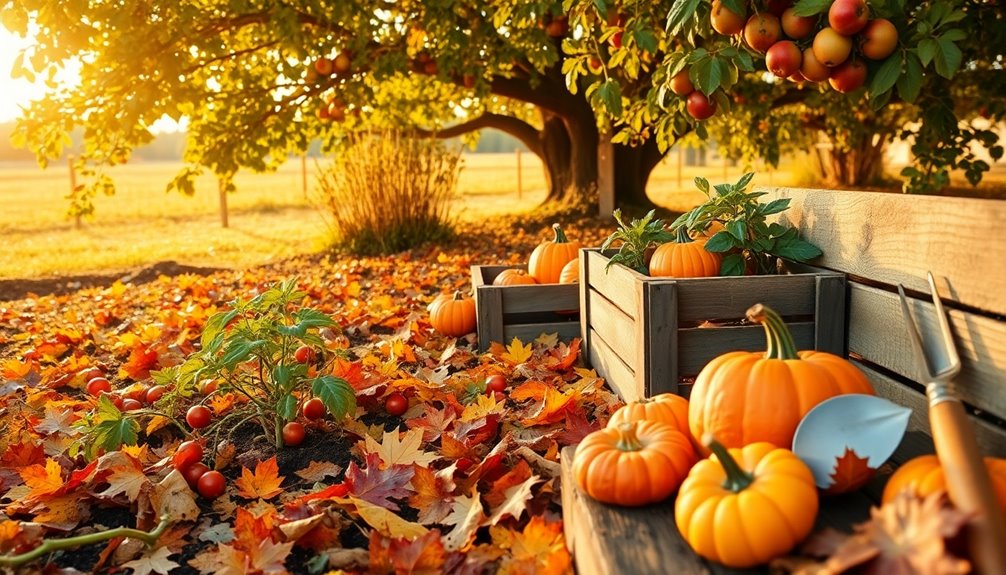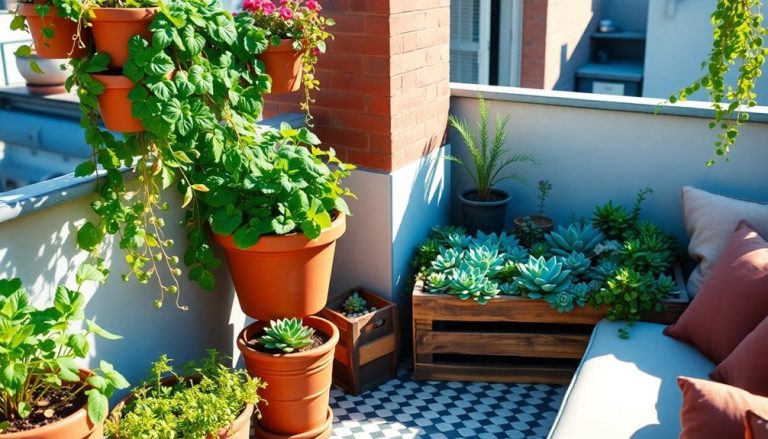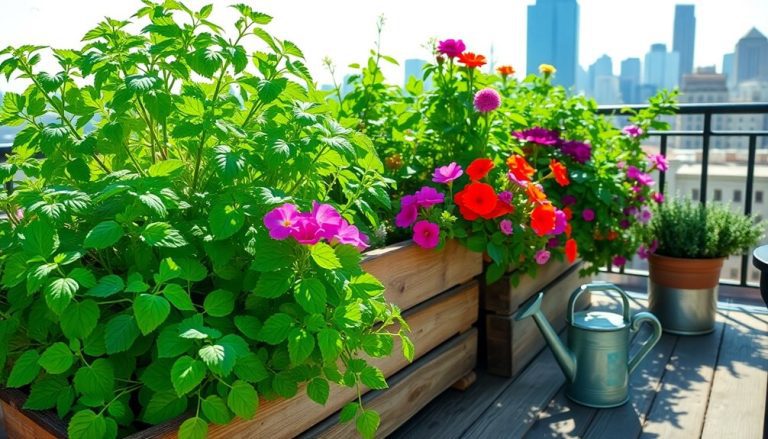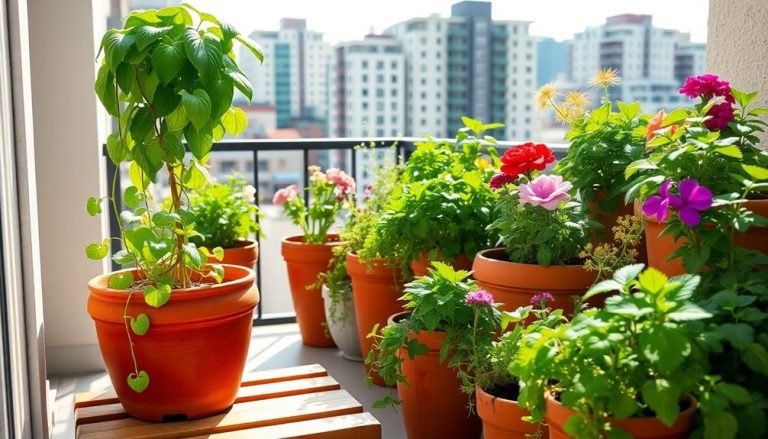Focusing on fall gardening tasks is crucial for creating a thriving garden all year. This season lets you plant cool-season crops, extend your growing period, and enjoy better flavor after frost. Plus, cooler temperatures make gardening more pleasant for you. You can enrich the soil, prepare for winter, and plant spring-blooming bulbs. Cleaning up dead plants also reduces pests and diseases, creating a healthier environment for your plants. By tackling these tasks, you set the stage for robust growth come spring. There's so much more to explore about how these efforts can benefit your garden!
Key Takeaways
- Fall gardening extends the growing season for cool-season crops, allowing for fresh produce well into autumn.
- Cooler temperatures reduce stress on plants, enhancing their flavor and overall health.
- Engaging in fall tasks improves soil health through organic matter addition and preparation for spring planting.
- Harvesting late-season crops before frost maximizes yield and flavor, providing additional food sources.
- Maintaining a tidy garden in fall prevents pest and disease issues, promoting a healthier garden ecosystem.
Benefits of Fall Gardening
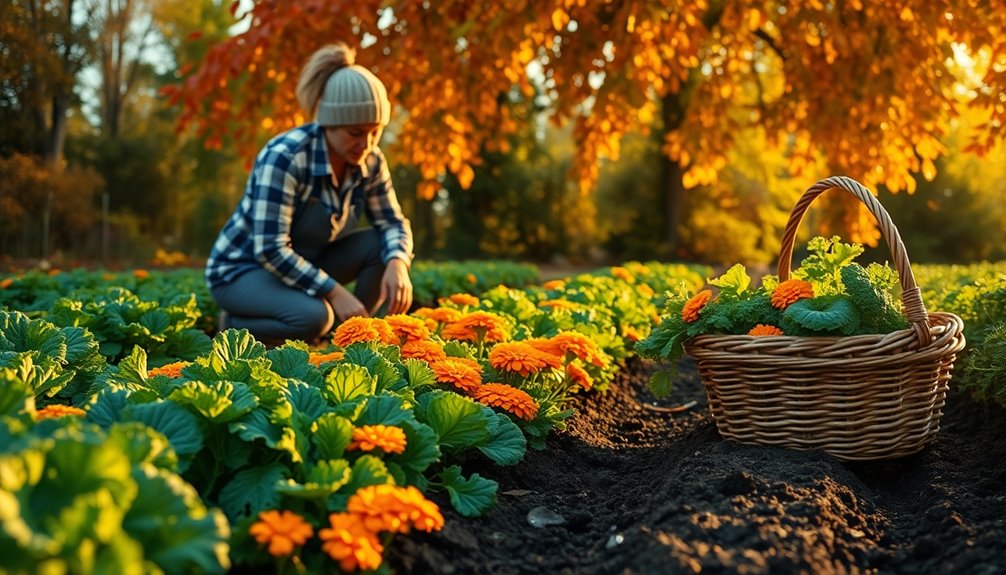
Fall gardening offers a unique set of benefits that can enhance your gardening experience. As temperatures cool, you'll find that certain plants thrive, allowing you to extend your growing season. This is the perfect time to plant cool-season crops like kale, spinach, and garlic. These crops not only handle the chill well but often taste even better after a frost. To optimize your success, consider using seed starting kits that can help you get your plants off to a great start.
In addition, fall gardening gives you a chance to work with less competition from pests and diseases. Many common garden nuisances begin to dwindle as the weather changes, creating a more favorable environment for your plants.
Plus, the reduced heat and sun intensity can make for more comfortable gardening sessions, letting you enjoy the process without breaking a sweat.
Another advantage is the opportunity to improve your soil. While you won't be preparing it just yet, the fall season is ideal for enriching your garden beds with organic matter, which will break down over winter and nourish your soil for next spring. Furthermore, fall gardening allows you to consult planting guides to help maximize your planting efforts and ensure a bountiful harvest.
Ultimately, fall gardening not only enriches your current growing experience but also lays a strong foundation for future gardening success. So, get ready to embrace the benefits of gardening in the fall!
Preparing Your Soil
To ensure your garden thrives in the cooler months, preparing your soil is crucial. Start by clearing out any dead plants and debris from the previous season. This helps prevent pests and diseases from lingering in your garden.
Next, consider testing your soil's pH and nutrient levels. You can buy a simple test kit or send a sample to a local extension service for analysis. Based on the results, you might need to amend your soil.
Incorporating organic matter, like compost or well-rotted manure, enriches your soil and improves its structure. Spread a layer of organic matter over your garden bed and mix it in with a garden fork or tiller. This not only boosts nutrients but also enhances drainage and aeration. Using a quality compost bin can help you create your own organic matter efficiently.
If your soil is heavy clay or sandy, consider adding gypsum or peat moss to improve texture. Don't forget to till the soil to a depth of at least 12 inches, allowing for better root penetration and nutrient absorption.
Lastly, cover your garden beds with mulch to retain moisture and protect your soil from erosion over winter. Using organic mulching materials can help maintain soil health and suppress weeds. By preparing your soil now, you'll set the stage for a flourishing garden come spring.
Planting Bulbs for Spring
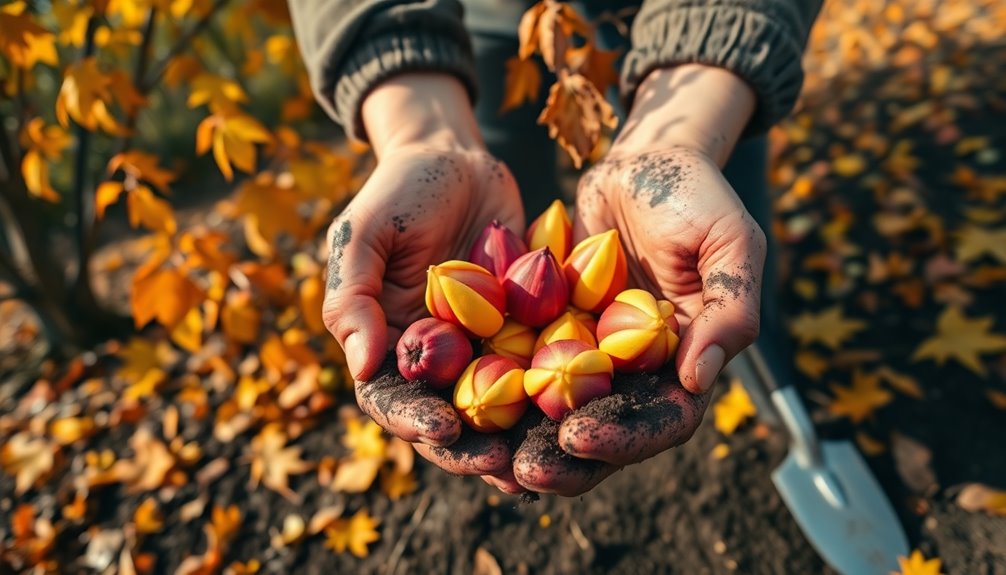
Planting bulbs for spring can transform your garden into a vibrant display of color and life. By choosing the right bulbs and planting them during the fall, you set the stage for a stunning spring show.
Start by selecting varieties that thrive in your climate, such as tulips, daffodils, or hyacinths. Additionally, consider incorporating edible flower seeds into your garden for added beauty and flavor.
Once you've gathered your bulbs, pick a sunny spot in your garden. Good drainage is crucial, so avoid areas where water tends to pool.
Dig holes that are about two to three times the height of the bulb. Place the bulbs in the holes with the pointed end facing up, and cover them with soil.
Water them lightly after planting to help settle the soil around them, but don't overwater. Mulching can also help protect the bulbs from extreme temperature fluctuations and retain moisture.
As winter fades and spring approaches, you'll be thrilled to see the first signs of life breaking through the soil.
With a little effort now, you're ensuring a burst of color that will brighten your garden and lift your spirits as the season unfolds.
Protecting Tender Plants
As temperatures begin to drop, protecting tender plants becomes essential for maintaining a healthy garden. Many plants, like annuals and tropical varieties, can't withstand frost and chilly nights. You'll want to take proactive steps to shield them from the cold.
Start by covering your tender plants with frost cloths or blankets during especially cold nights. These materials trap heat while allowing moisture and light to penetrate.
If you can, bring potted plants indoors or into a sheltered area, like a garage or basement, where temperatures remain more stable.
You might also consider using row covers or cloches for added protection. These not only guard against frost but also create a warmer microclimate around your plants. Be sure to remove them during the day to prevent overheating.
Mulching around the base of your tender plants can help insulate their roots, too. Use straw or shredded leaves to add an extra layer of protection.
Weeding and Mulching
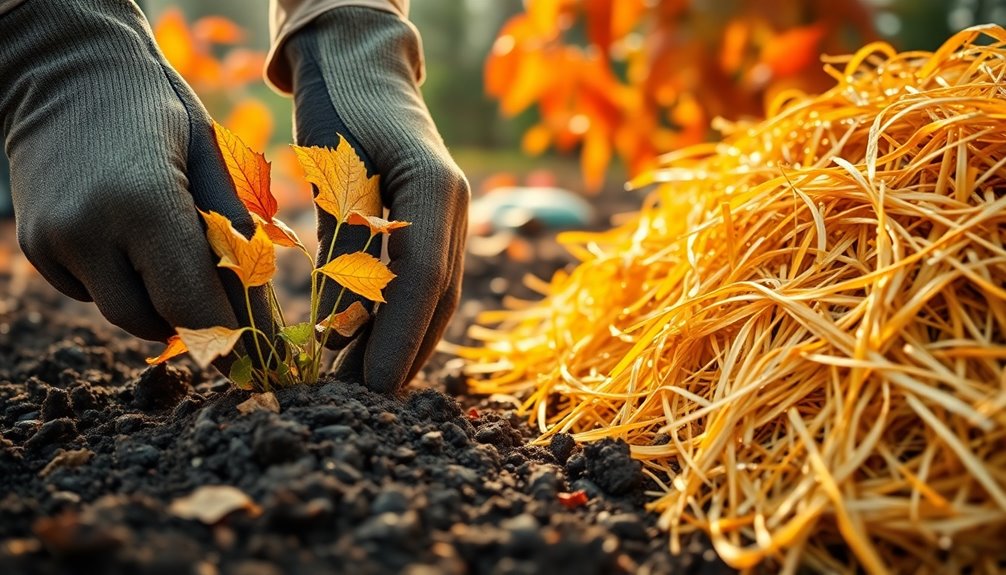
Weeding and mulching are crucial tasks for maintaining a healthy fall garden. As you prepare for the colder months, it's essential to keep your garden free of weeds that compete for nutrients and moisture. Weeds can harbor pests and diseases, so tackling them now will save you headaches later.
Regularly inspect your garden beds and pull any unwanted growth by hand or with a hoe. Make sure to remove the entire root to prevent regrowth.
Once you've cleared the weeds, it's time to mulch. Applying a layer of organic mulch, such as straw, leaves, or wood chips, helps suppress future weed growth while retaining soil moisture.
Mulch also regulates soil temperature, protecting plant roots against frost. Aim for a 2-4 inch layer, ensuring it doesn't touch the stems of your plants, as this could lead to rot.
Planning for Next Year
Looking ahead to next year's garden can be both exciting and beneficial for your fall preparations. As you wrap up this growing season, take time to reflect on what worked well and what didn't. Jot down notes about your favorite crops, their yields, and any pest issues you faced. This will help you make informed decisions come spring.
Consider your layout too. Did you have enough space for everything? Maybe you want to try companion planting or crop rotation to enhance your garden's health. Sketch out a new plan that incorporates these ideas while keeping in mind your seasonal preferences.
Don't forget to order seeds and supplies early. Many gardeners miss out on their favorites because they wait too long. By purchasing seeds now, you'll ensure you have everything you need to start strong when the ground thaws.
Finally, think about soil health. Consider adding organic matter or nutrients this fall to prepare for next year.
Harvesting Late Crops
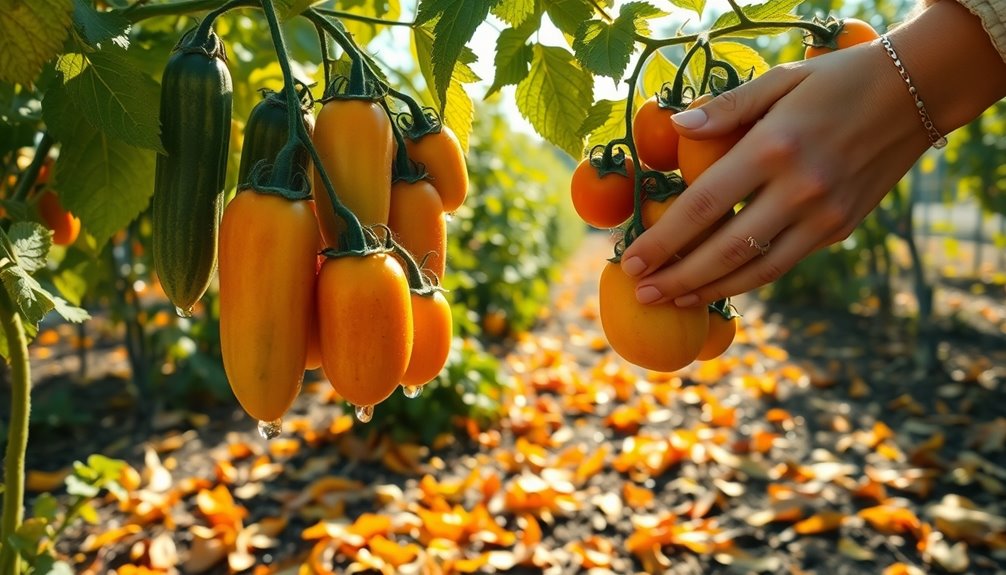
When it's time to wrap up your gardening season, don't overlook the importance of harvesting late crops. These crops can provide you with a bounty of fresh produce that extends the joy of gardening well into the fall.
Check your garden regularly for vegetables like kale, Brussels sprouts, and carrots, which often thrive in cooler temperatures.
Timing is key—harvest these late crops before the first frost hits, as some can be damaged by cold weather. Pull out your root vegetables when they're the right size, and don't hesitate to pick greens before they bolt.
Make sure to gather any remaining herbs as well; they can be dried or frozen for flavor throughout the winter.
Keep in mind that late-harvested crops can sometimes improve in flavor after a light frost, so don't rush if you still have time.
Also, make sure to clean up any debris around your plants to prevent disease next season.
Seasonal Pest Control
As the gardening season winds down, seasonal pest control becomes crucial to protect your plants and prepare for winter.
Pests can cause significant damage if left unchecked, so it's essential to take action now. Here are three key steps you should consider:
- Inspect Your Garden: Regularly check for signs of pests, such as holes in leaves or droppings. Early detection can help you manage infestations before they escalate.
- Clean Up Debris: Remove fallen leaves, dead plants, and any garden debris that can harbor pests. A tidy garden minimizes places for pests to hide and breed.
- Apply Natural Repellents: Consider using organic pest control methods, like neem oil or insecticidal soap. These options are effective and less harmful to beneficial insects, ensuring your garden remains healthy.
Frequently Asked Questions
What Tools Are Essential for Fall Gardening Tasks?
For fall gardening, you'll need essential tools like a sturdy spade, garden fork, pruners, gloves, and a rake. These help you prepare soil, prune plants, and clear debris, ensuring a thriving garden next season.
How Can I Extend My Gardening Season Into Winter?
To extend your gardening season into winter, consider using row covers, cold frames, and cloches. They shield plants from frost, retain warmth, and create a microclimate, allowing you to enjoy fresh produce even in colder months.
What Are the Best Fall Crops to Plant?
The best fall crops to plant include kale, spinach, and radishes. These varieties thrive in cooler temperatures and can withstand light frosts, ensuring you enjoy fresh produce even as the season changes.
Can I Grow Vegetables Indoors During Fall?
You can absolutely grow vegetables indoors during fall! For example, if you set up a small hydroponic system, you'll enjoy fresh lettuce and herbs throughout the season, ensuring your garden thrives regardless of the weather outside.
How Do I Prevent Fall Garden Pests?
To prevent fall garden pests, you'll want to regularly inspect your plants, remove any debris, and use organic deterrents. You can also introduce beneficial insects and cover plants with row covers to keep pests away.
Conclusion
As the leaves turn and the air cools, your fall gardening tasks become the seeds of tomorrow's blooms. By nurturing your soil and planting bulbs, you're crafting a masterpiece that will burst forth in spring. Weeding, mulching, and protecting tender plants are like wrapping a warm blanket around your garden, ensuring it thrives against the chill. Embrace this season as an artist prepares their canvas, setting the stage for the vibrant tapestry of life to come.

